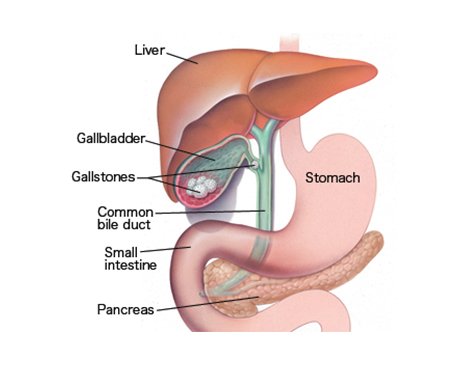Gallstones

Gallstones are small concretions that form in the gallbladder when a digestive juice called bile forms small crystals. Very tiny stones may cause no symptoms and are often picked up during diagnostic imaging for another issue. Larger stones can cause irritation and even block the gallbladder ducts, leading to pain and possible infection.
Symptoms of Gallstones
Symptom ‘flare-ups’ are often referred to as gallbladder attacks, and they occur most commonly after meals.
Severe pain or throbbing in the upper abdomen, back, or right shoulder blade is a common symptom of gallbladder problems. Some people may also experience a dull ache beneath the rib cage, along with nausea or vomiting. In cases of infection, fever may develop. More serious symptoms can include jaundice, which causes yellowing of the skin and eyes, itching, and dark-colored urine.
How are gallstones treated?
If gallstones aren’t causing symptoms, doctors may recommend a “wait-and-see” approach, with regular monitoring instead of immediate treatment.
When gallstones cause no symptoms, a ‘wait-and-see’ approach may be recommended to monitor the stones and decide if surgery is needed in the future. However, for patients who experience one or more gallbladder attacks, surgery to remove the gallbladder (cholecystectomy) is usually advised. This helps prevent the formation of additional stones and reduces the risk of serious complications such as infection or pancreatitis.
During Gallbladder Surgery
Most gallbladder removals are done laparoscopically, using a few small incisions instead of one large cut. This approach usually means less pain and faster healing.
Gallbladder surgery is usually done laparoscopically through a few small incisions. A camera and instruments are inserted to remove the gallbladder, with gas used to gently inflate the area for better visibility. The incisions are then closed. Most procedures are outpatient, with patients going home the same day and returning to work in about a week.
How Gallbladder Removal Works
The surgeon uses tiny incisions and a camera to remove the gallbladder, usually allowing patients to go home the same day.
The surgeon makes a few small incisions in the abdomen and uses a tiny camera and special instruments to remove the gallbladder. The area is gently inflated with gas for a clear view. Most surgeries are laparoscopic, which means less pain, smaller scars, and a quicker recovery—often with patients going home the same day.
Testimonials
Words from our patients
Our Locations
Choose your preferred location
Contact with us!
Have questions or feedback? Simply complete the contact form below.






